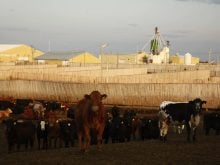This cattle market information is selected from the weekly report from Canfax, a division of the Canadian Cattlemen’s Association. More market information, analysis and statistics are available by becoming a Canfax subscriber by calling 403-275-5110 or at www.canfax.ca.
Fed cattle down
The Canfax weighed average steer price was $131.63 per hundredweight, down $2.95. There was no heifer average.
After being at a premium to the Nebraska market for the past six weeks, Alberta fed prices fell to a $3 discount.
Read Also

Huge Black Sea flax crop to provide stiff competition
Russia and Kazakhstan harvested huge flax crops and will be providing stiff competition in China and the EU.
With a few more non-fed cattle starting to seasonally show up, and rumblings that packers are going to start reducing hours by dropping Saturday shifts, demand for fed cattle has moderated.
Sale volumes were light and a number of cattle were carried over to the next week.
Cattle were scheduled for Oct. 9 or Oct. 16 delivery.
Western Canadian steer car-casses to Sept. 23 averaged 924 pounds, the largest since October last year but four lb. below last year at the same point. The larger carcasses have led to more yield grade 3 cattle.
Market-ready fed numbers should start to moderate.
However, note that in the first four months of the year there was an elevated number of light cattle placed on feed.
January to April calves and light stockers weighing less than 700 lb. were up 24 percent, or 32,000 head, compared to last year.
Many of these light placements will be sold in the fourth quarter fed market.
Canada to U.S. cash-to-cash basis levels usually weaken from September to October, which is traditionally the weakest basis month for the second half of the year.
In the United States, a few cattle in Texas and Kansas brought US$108 per cwt., steady with the previous week.
Other sellers in the U.S. Plains were holding out for at least $110.
Cows rise
Non-fed prices firmed with good demand on a moderate auction offering.
D1, D2 cows ranged C$80-$94 to average $87.43, up $1.71. D3 cows ranged $70-$87 to average $78.
Butcher bulls averaged $100.55, up 40 cents.
Weekly western Canadian non-fed slaughter to Sept. 23 was steady at 5,761 head. For the year, slaughter is up 11 percent.
Exports to Sept. 16 rose seven percent to 4,293 head. They are down 25 percent for the year.
Feeders rise
Calves 300-400 lb. rose sharply, and 400-500 lb. feeders saw modest gains.
Calves from 500-700 lb. rose on good demand by $3.50-$5.
Deferred October-November delivery pricing for quality calves was steady with spot delivery.
Large feeders heavier than 700 lb. rose $1-$3.
Feeder exports to Sept. 16 slowed to a trickle at 336 head, the smallest volume since early January.
Western Livestock Price Insurance is a viable risk management option, but coverage falls short of break-even.
An 850 lb. steer placed against the April live contract would require a +$7 basis to break even. LPIP fed insurance provides no more than general disaster coverage.
Summer basis contracts look promising and could be an option.
Auction volumes should increase as harvest winds down.
Stocker calves could see prices rise, while larger feeders are generally expected to be steady.
US beef up
U.S. boxed beef prices to Sept. 28 rose with Choice up US$2.32 at $196.64 and Select up $1.80 at $189.11.
Choice ribs surged $21 per cwt., indicating that buyer interest for the holiday season might be picking up.
Weekly Canadian cutouts to Sept. 23 saw AAA down C$7.23 at $239.20 and AA down 92 cents at $232.16.
With the Canadian Thanks-giving long weekend around the corner, the focus at retail will be turkey and ham.
In the U.S., October is pork promotion month, but U.S. retailers are still enjoying good margins on beef and should continue to have features at the meat counter.
















